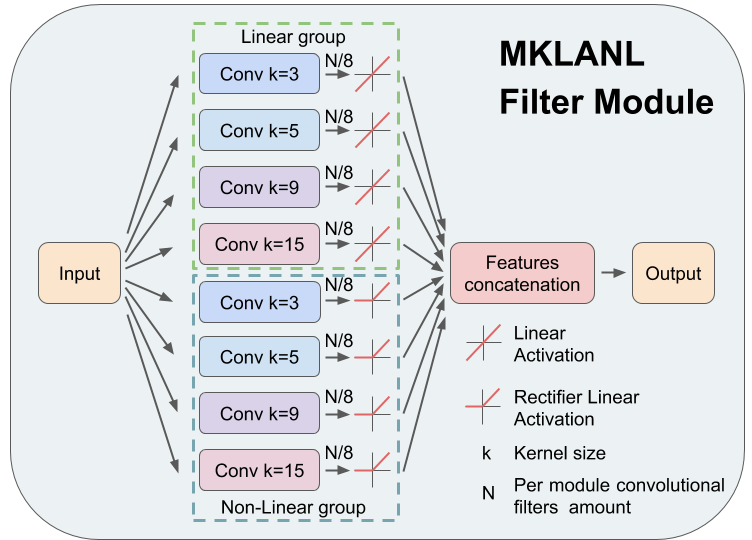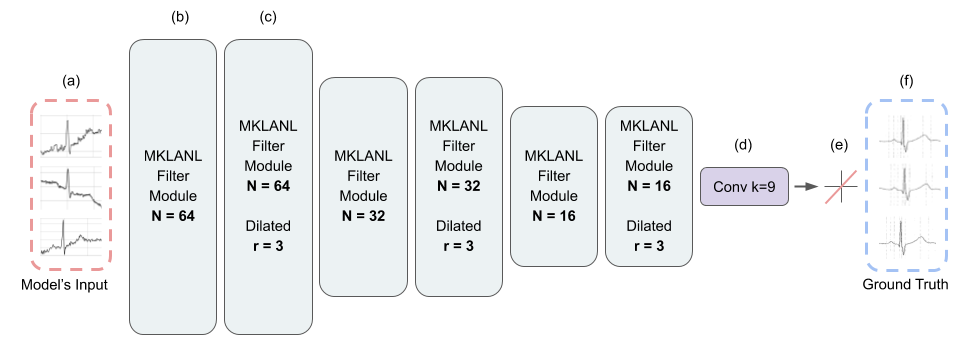For a more theoretical information please visit our paper in the journal Biomedical Signal and Control: https://www.sciencedirect.com/science/article/abs/pii/S1746809421005899
This repository contains the codes for DeepFilter a deep learning based Base line wander removal tool. This repo follows the last version of the paper where some changes on the experiment scheme were requested by the reviewers.
Since for us reproducibility is KEY on research, and we understand that some folks will find and read only the Arxiv version, we have decided to create a separate repository https://github.com/fperdigon/DeepFilter_as_in_Arxiv that follows the experiment scheme described in the preprint Arxiv paper https://arxiv.org/pdf/2101.03423.pdf
This repository also contains other classical and deeplearning filters solutions implemented for comparison purposes.
The deep learning models were implemented using Keras/Tensorflow framework.
According to the World Health Organization, around 36% of the annual deaths are associated with cardiovascular diseases and 90% of heart attacks are preventable. Electrocardiogram signal analysis in ambulatory electrocardiography, during an exercise stress test, and in resting conditions allows cardiovascular disease diagnosis. However, during the acquisition, there is a variety of noises that may damage the signal quality thereby compromising their diagnostic potential. The baseline wander is one of the most undesirable noises.
In this work, we propose a novel algorithm for BLW noise filtering using deep learning techniques. The model performance was validated using the QT Database and the MIT-BIH Noise Stress Test Database from Physionet. We implement an Inception inspired multibranch model that by laveraging the use og multi path modules and dilated convolutions is capable of filtering BLW while preserving ECG signal morphology and been computational efficient.
The following figure shows the multipath module using dilated convolutions.

The following figure shows the overall model architecture.

In addition, we compared our approach against state-of-the-art methods using traditional filtering procedures as well as deep learning techniques. This other methods were implemented by us in python
- FIR Filter (using Scipy python library). Reference paper: Francisco Perdigón Romero, Liset Vázquez Romaguera, Carlos Román Vázquez-Seisdedos, Marly Guimarães Fer-nandes Costa, João Evangelista Neto, et al. Baseline wander removal methods for ecg signals: A comparativestudy.arXiv preprint arXiv:1807.11359, 2018.
- IIR Filter (using Scipy python library). Reference paper: Francisco Perdigón Romero, Liset Vázquez Romaguera, Carlos Román Vázquez-Seisdedos, Marly Guimarães Fer-nandes Costa, João Evangelista Neto, et al. Baseline wander removal methods for ecg signals: A comparativestudy.arXiv preprint arXiv:1807.11359, 2018.
- Deep recurrent neural networks (DRRN). Reference paper: Karol Antczak. Deep recurrent neural networks for ecg signal denoising.arXiv preprint arXiv:1807.11551, 2018
- Full Convolutional Net Denoinsing Autoencoders (FCN-DAE). Reference paper: Hsin-Tien Chiang, Yi-Yen Hsieh, Szu-Wei Fu, Kuo-Hsuan Hung, Yu Tsao, and Shao-Yi Chien. Noise reduction in ecg signals using fully convolutional denoising autoencoders.IEEE Access, 7:60806–60813, 2019.
The proposed approach yields the best results on four similarity metrics: the sum of squared distance, maximum absolute square, percentage of root distance, and cosine similarity.
The following table present the quantitative results of DeepFilter Net compared on the same test set with other SOTA
methods.

Qualitative results
The figure shows a portion of sele0106 ECG signal.

Original ECG + BLW noise from the NSTDB.

The blue line is the ECG filtered using our approach.Metric values are also included.

The brown signal is the ECG recovered using the IIR filter, this image was included for visual comparison purposes. Metric values are also included.

The firts step is to clone this repository
git clone https://github.com/fperdigon/DeepFilter
Then lets prepare the dataset.
If you are using Windows open Powershell using the cd command place yourself on inside the repository folder, then execute the download_data.ps1 Powershell script using the command:
powershell -ExecutionPolicy Bypass -File '.\download_data.ps1'
If you are using a Unix-like system such as Linux, MacOS, FreeBSD, etc open a console in the path of DeepFilter code, then execute the download_data.sh bash file.
bash ./download_data.sh
The next step is to create the Conda environment using the provided environment.yml file. For this step you need the conda python package manage installed. In case you don't have it installed we recommend installing Miniconda to avoid installing unnecessary Python packages.
To create the conda environment run the following command:
conda env create -f environment.yaml
Then activate the Python environment you just created with the following command:
conda activate DeepFilter
Finally start the training and the experiments by running the command:
python DeepFilter_main.py
This python script will train all the models, execute the experiments calculate the metrics and plot the result table and some figures.
If you have a Nvidia CUDA capable device for GPU acceleration this code will automatically use it (faster). Otherwise the training will be done in CPU (slower).
When citing DeepFilter please use this BibTeX entry:
@article{romero2021deepfilter,
title={DeepFilter: an ECG baseline wander removal filter using deep learning techniques},
author={Romero, Francisco P and Pi{\~n}ol, David C and V{\'a}zquez-Seisdedos, Carlos R},
journal={Biomedical Signal Processing and Control},
volume={70},
pages={102992},
year={2021},
publisher={Elsevier}
}
The MIT License (MIT)
Copyright (c) 2021 Francisco Perdigon Romero, David Castro Piñol
Permission is hereby granted, free of charge, to any person obtaining a copy of this software and associated documentation files (the "Software"), to deal in the Software without restriction, including without limitation the rights to use, copy, modify, merge, publish, distribute, sublicense, and/or sell copies of the Software, and to permit persons to whom the Software is furnished to do so, subject to the following conditions:
The above copyright notice and this permission notice shall be included in all copies or substantial portions of the Software.
THE SOFTWARE IS PROVIDED "AS IS", WITHOUT WARRANTY OF ANY KIND, EXPRESS OR IMPLIED, INCLUDING BUT NOT LIMITED TO THE WARRANTIES OF MERCHANTABILITY, FITNESS FOR A PARTICULAR PURPOSE AND NONINFRINGEMENT. IN NO EVENT SHALL THE AUTHORS OR COPYRIGHT HOLDERS BE LIABLE FOR ANY CLAIM, DAMAGES OR OTHER LIABILITY, WHETHER IN AN ACTION OF CONTRACT, TORT OR OTHERWISE, ARISING FROM, OUT OF OR IN CONNECTION WITH THE SOFTWARE OR THE USE OR OTHER DEALINGS IN THE SOFTWARE.